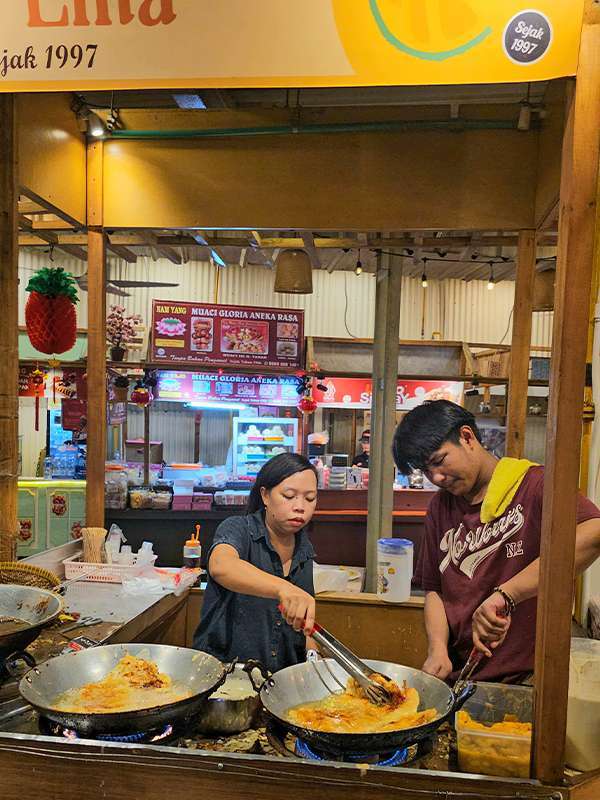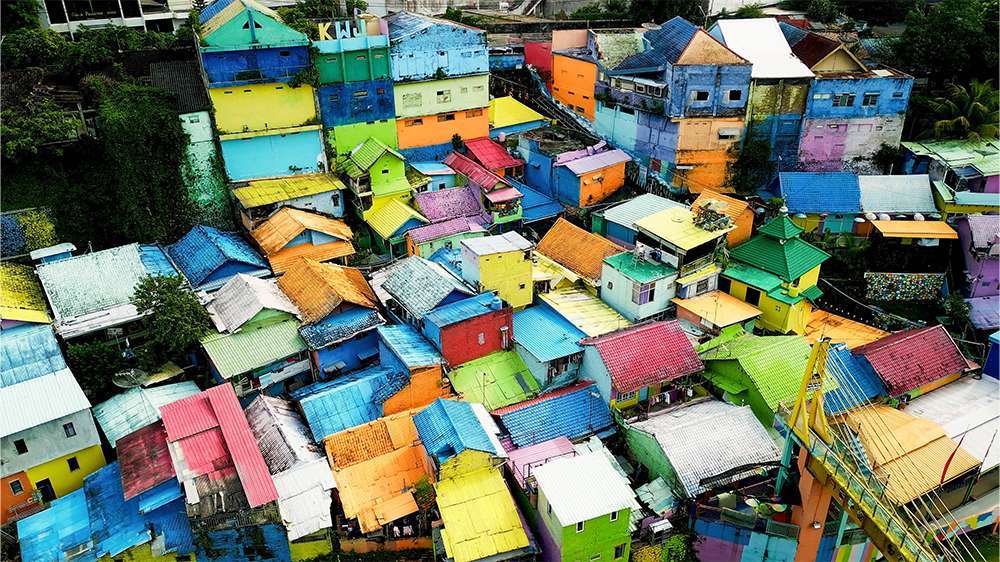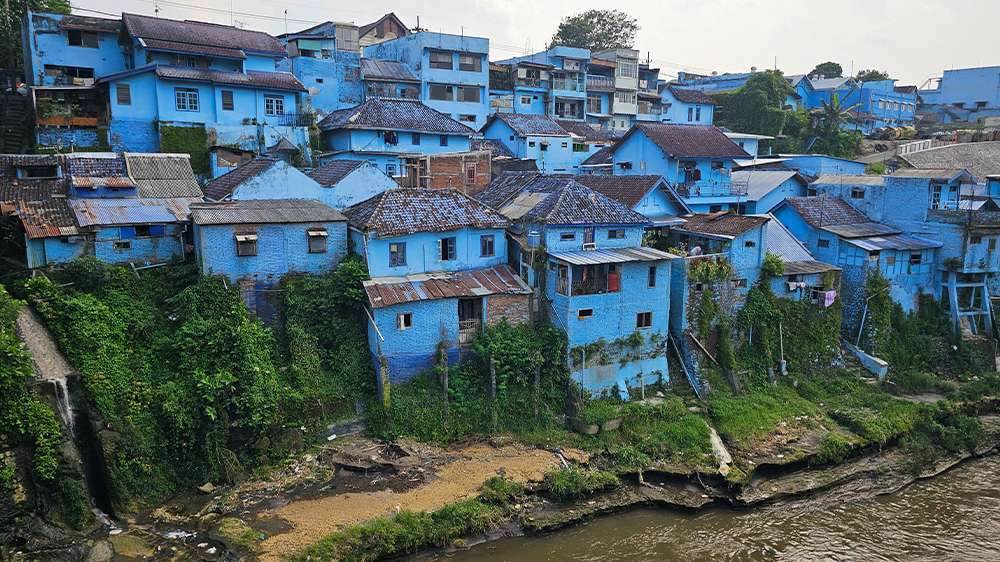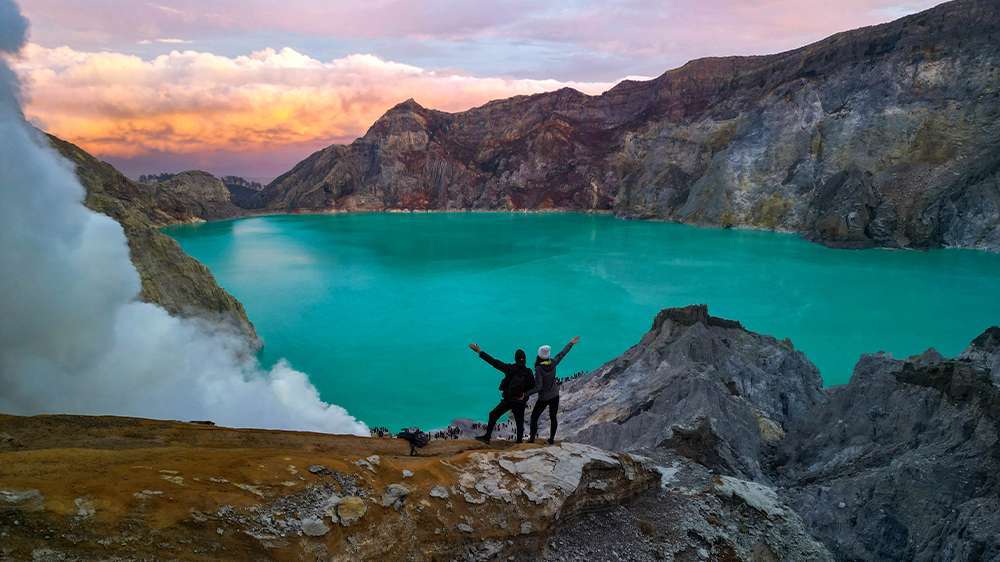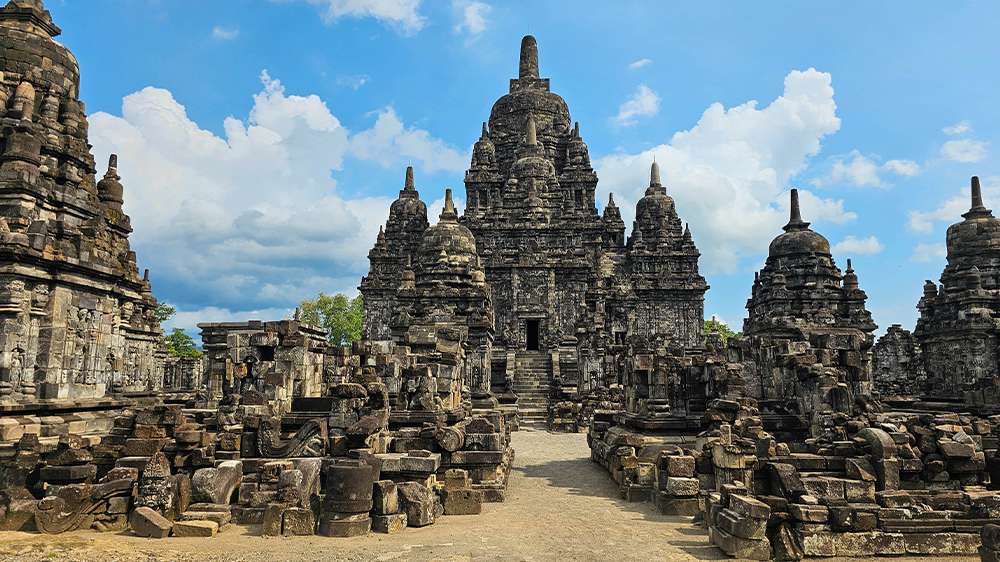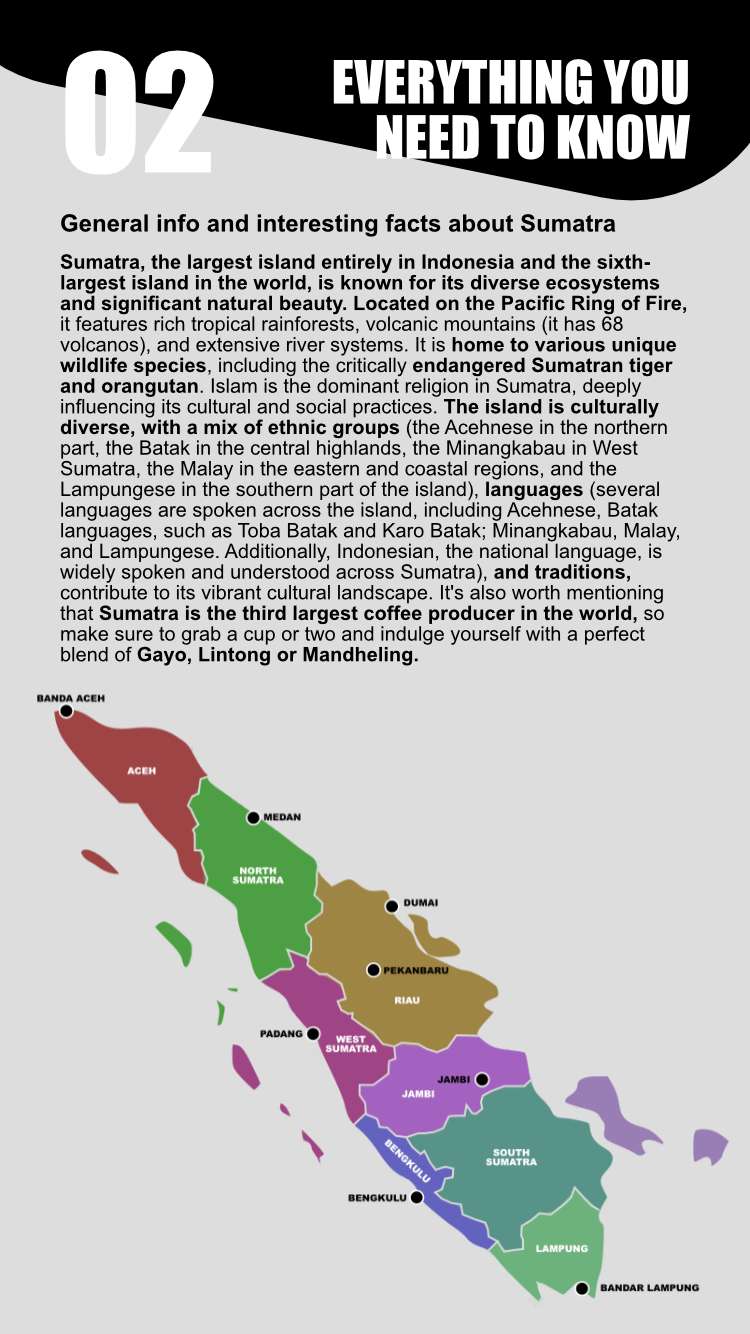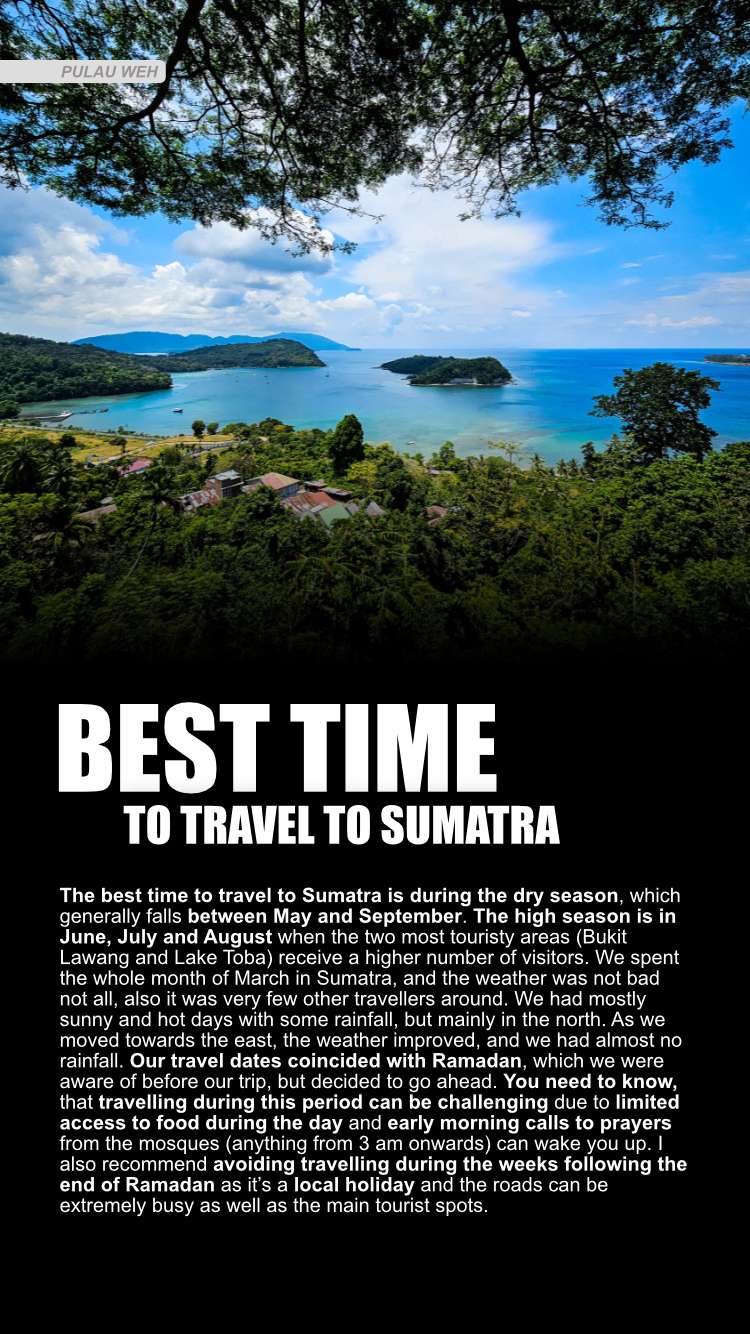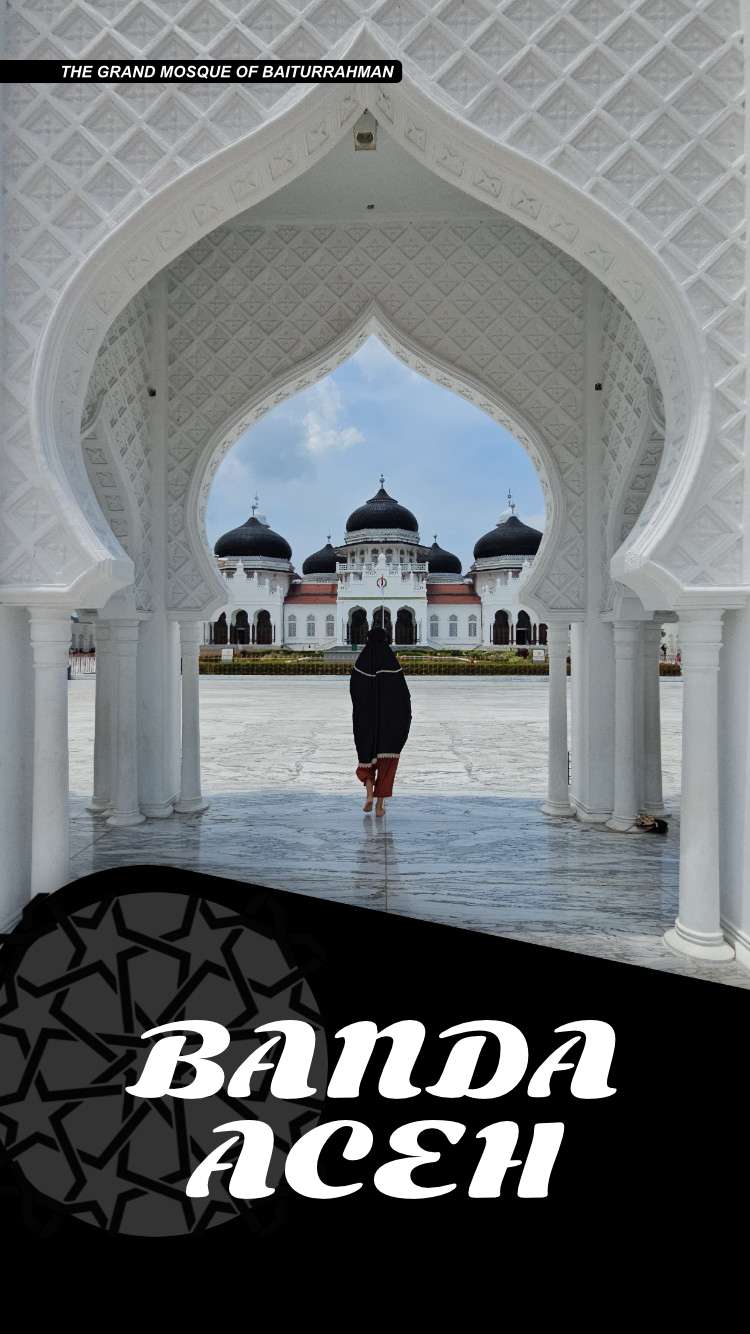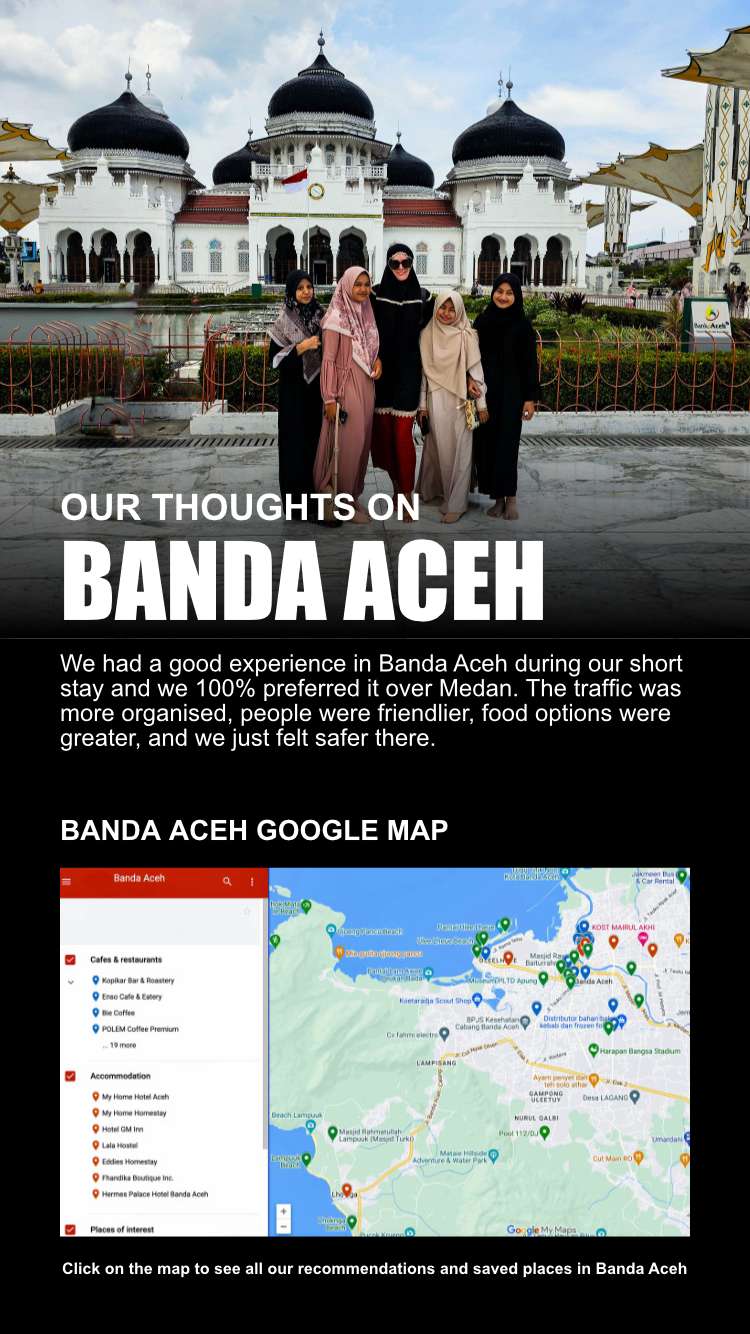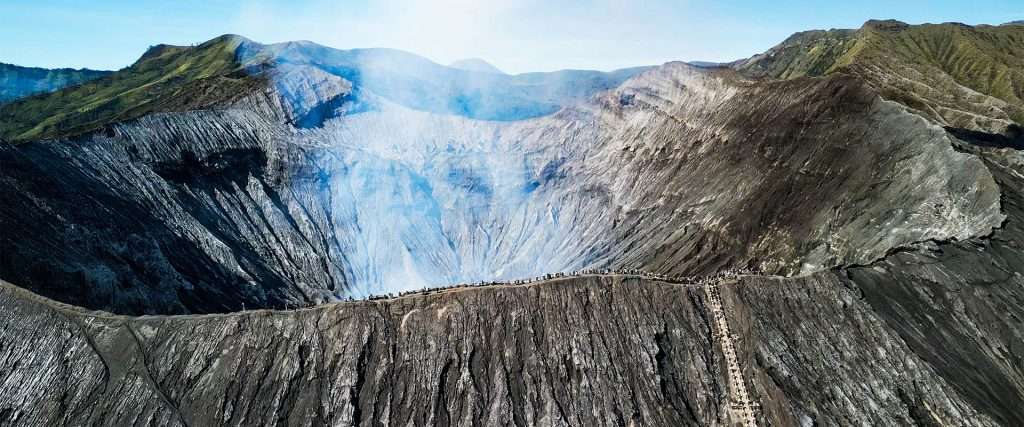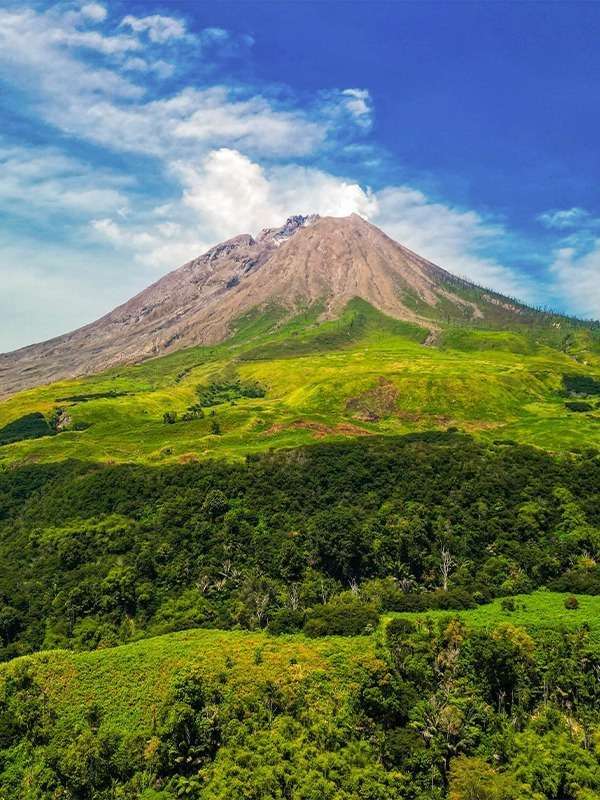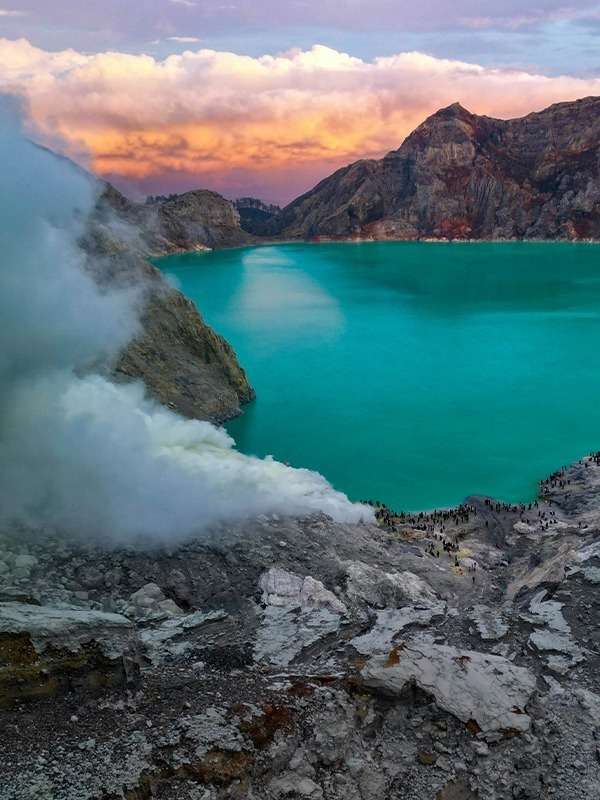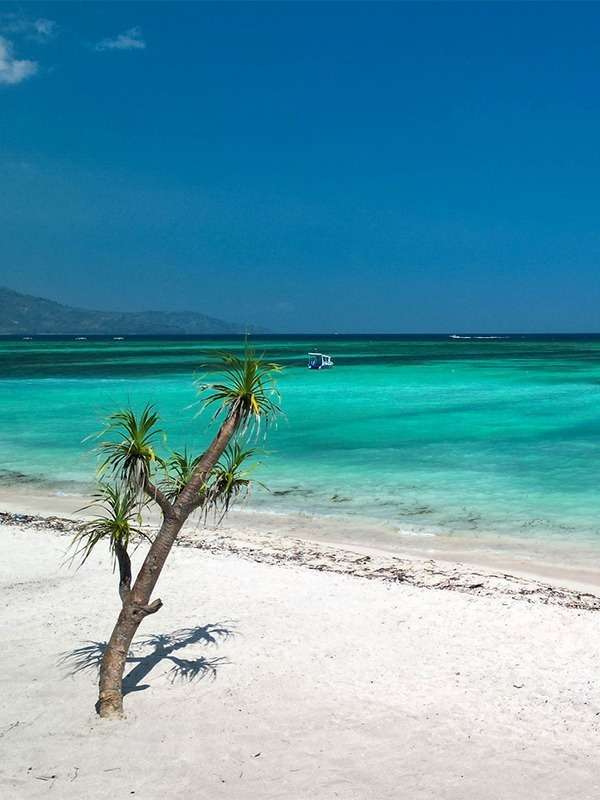This Java travel guide introduces you to Indonesia’s beating heart: an island of ancient temples, fiery volcanoes, and lively cities. While many travellers set their sights on Bali, Java is where culture and adventure collide. Imagine watching the sunrise over Mount Bromo, wandering through the awe-inspiring temples of Borobudur and Prambanan, or getting lost in the energy of Yogyakarta and Jakarta.
Our journeys through Java have shown us just how diverse this island is, from quiet mountain villages to bustling city streets. In this guide, I’ll share essential travel info, practical tips, and the most unforgettable experiences to help you plan your trip.
For a detailed route, check out our Ultimate 10-Day Java Itinerary, where we break down the best way to experience this incredible island.
Excited to explore Java? Let’s get started!
Java at a Glance: Key Facts and Travel Insights
Geography and Location of Java
Java, the heart of Indonesia, is the country’s most populous and culturally diverse island. Stretching over 1,000 km between Sumatra and Bali, it offers a mix of dramatic volcanoes, lush rice fields, vibrant cities, and coastal escapes. It’s also home to Jakarta, Indonesia’s capital and economic hub.
From ancient temples and breathtaking waterfalls to iconic spots like Mount Bromo and Kawah Ijen, Java is packed with incredible experiences. Explore Yogyakarta’s cultural heritage, Semarang’s colonial charm, or Surabaya’s lively streets; there’s something for everyone.
Did you know?
Indonesia is home to more volcanoes than any other country in the world! With over 130 active volcanoes, it sits on the Pacific Ring of Fire, making it one of the most geologically dynamic places on Earth. Some, like Mount Bromo and Mount Rinjani, are popular hiking spots, while others, like Krakatoa, have shaped history with their massive eruptions.
Despite the risks, these volcanoes create lush landscapes, fertile soil, and even unique blue flames, like those at Kawah Ijen, where sulfuric gas ignites in the dark. A truly otherworldly sight!
Religion and Language in Java
Java is a vibrant cultural hub within Indonesia, showcasing the country’s rich diversity. The island is predominantly Muslim, with grand mosques and Islamic traditions shaping daily life. However, Java is also home to Christian, Hindu, and Buddhist communities, adding to its rich cultural heritage. You’ll find stunning temples, unique ceremonies, and a blend of traditions across the island.
Bahasa Indonesia is the official language, but regional languages like Javanese and Sundanese are widely spoken, especially in local villages and markets. While English is common in tourist areas, learning a few basic Bahasa Indonesia phrases will enhance your experience and help you connect with locals.
Here are the most essential phrases to know
Hello | Greetings:
Selamat Pagi
Thank You:
Terima Kasih
Excuse me:
Permisi
Culture and Food in Java
Java is the cultural heart of Indonesia, home to ancient traditions, historic temples, and a blend of Javanese, Sundanese, and other ethnic influences. From the art of batik and traditional gamelan music to vibrant wayang (shadow puppet) performances, the island’s heritage is deeply rooted in everyday life.
If you love street food, Java won’t disappoint! The island’s cuisine is packed with rich flavours, from the sweet and savoury gudeg (jackfruit stew) in Yogyakarta to the spicy rendang and comforting soto (savoury soup). Wander through local markets and try favourites like pecel lele (fried catfish) and lumpia (spring rolls). From bustling cities to quiet villages, tasting your way through Java is an experience in itself!
Top Activities to Experience in Java
From dynamic cities to breathtaking landscapes, Java is packed with unforgettable adventures. In this Java Travel Guide, we’ve rounded up the absolute must-do activities, from exploring ancient temples to witnessing epic volcanic sunrises. If you love history, nature, or adventure, these top experiences belong on your itinerary.
Explore Jakarta, Indonesia’s Capital
As the bustling capital, Jakarta offers a dynamic blend of modernity and tradition. Visit iconic landmarks like the National Monument and Kota Tua, and dive into the local food scene and vibrant markets.

Discover Malang’s Colourful Streets
Malang is famous for its bright and colourful destinations like Jodipan and the Blue Village. Walking through these vibrant neighbourhoods is a feast for the eyes and a great way to experience the city’s artistic spirit.
Hike to Mount Bromo
A sunrise trek to Mount Bromo is one of the top things to do in Java. Watching the sunrise over the active volcano and the surrounding sea of sand is an unforgettable experience.

Trek to Ijen Crater
For nature lovers and thrill-seekers, Ijen Crater is a must-see. The trek to witness the blue flames and sulphur mining is both challenging and rewarding.
Admire Tumpak Sewu Waterfall
Located in East Java, Tumpak Sewu is one of the most stunning waterfalls we’ve ever seen. The view from above is breathtaking, and the hike to get there is an adventure in itself.
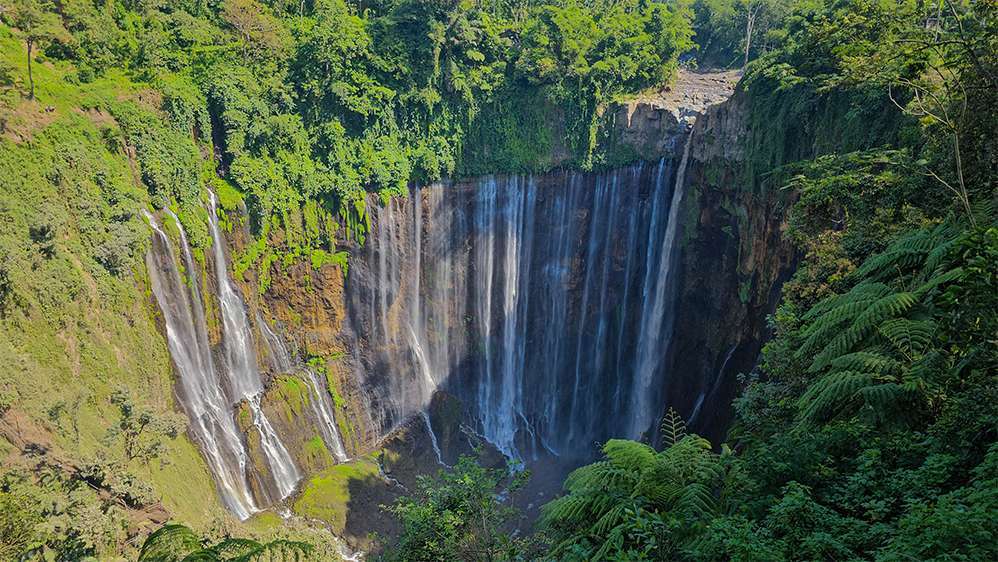
Explore Yogyakarta’s Temples
Yogyakarta is rich in cultural history, and no visit is complete without seeing the UNESCO-listed Borobudur and Prambanan temples. These ancient wonders offer a glimpse into Indonesia’s spiritual heritage.
Java Travel Guide: Essential Travel Tips & Must-Know Information
Planning a trip to Java? Our Java travel blog is here to help you navigate the island’s stunning landscapes and vibrant cultural experiences. To make the most of your adventure, we’ve gathered essential travel tips to ensure your journey is smooth and unforgettable.
Transportation in Java
How to Get to Java
- Flights: Most travellers arrive in Java via Soekarno-Hatta International Airport (CGK) in Jakarta, Kualanamu International Airport (MED) in Medan (North Sumatra), or Juanda International Airport (SUB) in Surabaya. Daily direct flights are available from major international hubs, with budget airlines like AirAsia and Lion Air offering affordable connections to nearby countries and islands. For the best deals, check platforms like Skyscanner and Traveloka
- Ferries: If you’re coming from Bali, ferries are a popular option. The ferry from Bali to Java (Gilimanuk to Banyuwangi) takes about 30 minutes and is a scenic way to travel between the islands
Getting Around Java
- Domestic Flights: The fastest way to travel between cities in Java. Popular routes connect Jakarta (CGK), Surabaya (SUB), Yogyakarta (YIA), and other major destinations. Airlines like Garuda Indonesia, Lion Air, and Citilink provide frequent connections
- Trains: Java has a well-connected and scenic train system that is both affordable and comfortable. Major routes link popular cities like Jakarta, Yogyakarta, Surabaya, and Malang, allowing you to enjoy beautiful landscapes along the way
- Scooter Rentals: Renting a scooter is a great way to explore Java’s smaller towns and rural areas. It’s an affordable, flexible, and fun option for those who enjoy a bit of adventure
- E-Hailing Services: In larger cities like Jakarta, Surabaya, and Yogyakarta, Grab and Gojek are convenient and affordable ways to get around
- Walking: Walking in Java is a great way to explore cities like Jakarta, Malang, and Yogyakarta. Strolling through these cities’ streets lets you soak in the local culture and discover hidden gems that might be missed when travelling by other means
For easy transport bookings, use Trip.com, Skyscanner, 12go, and Traveloka for schedules and reservations.
Best Time to Visit Java
The dry season, from April to October, is the ideal time to explore Java, offering sunny weather perfect for outdoor activities. However, if you’re looking to avoid peak crowds and prices, travelling just before or after the dry season is a great option. Here’s a quick breakdown:
April to October (Dry Season)
- Best for sunshine and outdoor adventures
- Fewer crowds and lower prices if you visit just outside the peak months
July and August (Peak Season)
- High demand, especially in popular spots like Mount Bromo and Kawah Ijen
- Perfect weather with little rainfall and low humidity
- Book accommodation and tours well in advance to secure the best options
Tip: Plan ahead if you’re visiting during peak season to ensure you get the best accommodation and guides for iconic destinations like Mount Bromo and Kawah Ijen.
Visa Requirements for Java
Before travelling to Java, it’s important to understand the visa requirements and timelines. Here are your main options:
- Visa on Arrival (VOA): Available for IDR 500k, this visa is valid for 30 days, with the option to extend for an additional 30 days
- e-VOA: Apply online before your departure. The cost and conditions are the same as the VOA, but it’s a more convenient option
For more details and to apply for the e-Visa, visit the Official e-Visa Website.
Visa Extension
If you plan to extend your visa, make sure to start the process at least 7 days before your current visa expires. The extension process requires three visits to the immigration office:
- Submit your documents and make the payment
- Have your photo and fingerprints taken
- Collect your passport with the extended visa
For a quicker and more convenient option, consider applying for an e-VOA online. This allows you to avoid in-person visits and can even speed up the extension process, sometimes taking as little as one day.
Staying Connected in Java
e-SIM (Best for Convenience)
- Instant activation, no physical SIM card required
- Recommended: Airalo – Use code JUDIT4949 for US$3 off on your first data pack
Tourist SIM Cards (Best for Data Plans)
- Purchase from official stores like Telkomsel or Grapari (avoid buying from airports)
- A passport is required for registration
- Plans start at IDR 200k for 20GB (valid for 30 days)
- Use the My Telkomsel app to manage your plan
- IMEI registration expires after one month (you can re-register twice per device)
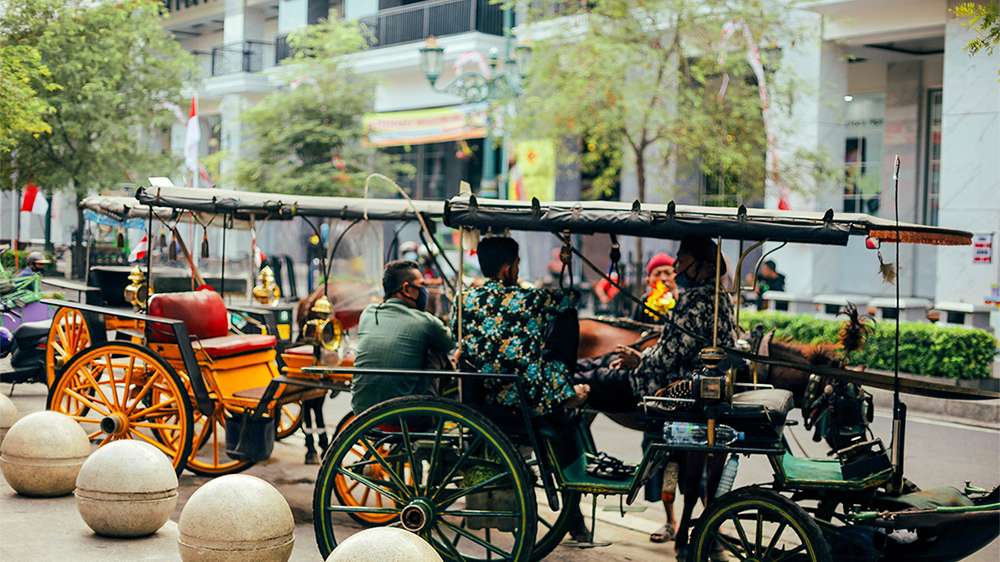
Money and ATMs
The local currency is the Indonesian Rupiah (IDR). While card payments are accepted in cities like Jakarta and Yogyakarta, it’s still a good idea to carry cash, especially for small shops or street food.
ATMs are widely available in most cities, with withdrawal limits ranging from IDR 1.25 million to IDR 2.5 million. Banks like BNI, BRI, Mandiri, and BCA usually don’t charge extra fees.
For better exchange rates, avoid airport exchanges and consider using travel cards like Revolut or Monzo.
Sign up for Monzo today and get a £5 bonus after your first payment.
Budgeting and Costs
Java is still affordable, but prices can be slightly higher compared to the rural parts of Sumatra. We budgeted around $50 per person per day, though it’s easy to spend less with the variety of budget options available.
Accommodation in Java can be found for around IDR 100k to 300k(USD 6-20) for budget hostels. Mid-range private hotel rooms typically start around IDR 300k to 600k (USD 20-40). In popular destinations like Yogyakarta, Surabaya, or Jakarta, prices can be slightly higher, especially in well-known areas.
Budget Breakdown
- Accommodation: $6 – $40 per night
- Food: $5 – $10 per day
- Transport: $5 – $15 per day
- Activities: $10 – $50* per day
Total Daily Cost: $26 – $115 (depending on your travel style)
* Note on Activities:
- For East Java tours, including Mount Bromo and Kawah Ijen, expect to pay between $150 – $250 for a 3-day all-inclusive package
- Visiting Borobudur and Prambanan with sunrise costs around $45, including entrance fees
Drone Regulations in Java
Flying drones is legal in Indonesia, but there are important rules and regulations to keep in mind to ensure a safe and respectful experience:
- Altitude: Drones must stay below 150 meters (500 feet) unless you have special permission.
- Restrictions: It’s strictly prohibited to fly drones at or above temples, including iconic spots like Borobudur and Prambanan
- Drones are also prohibited in Jakarta’s city centre due to airspace regulations
- Always avoid flying over crowds, government buildings, and other restricted zones
- Permits: If you’re using a drone for professional purposes or filming for commercial reasons, you’ll need a permit
Tip: When flying around natural landmarks like Tumpak Sewu, be extra cautious. GPS signal loss is common in the valley, which can lead to your drone crashing if you’re not careful.
For more details and to stay updated, make sure to consult local regulations or contact aviation authorities in Indonesia before flying.
Health and Safety Tips
To ensure a safe and healthy trip to Java, keep these essential tips in mind:
- Stay Hydrated & Protected: Drink bottled water (avoid tap water, even when brushing your teeth), use sunscreen regularly, and apply mosquito repellent (Soffell) to protect yourself from dengue
- Helmet Use: Always wear a helmet when riding scooters or motorcycles for safety
- Vaccinations: Make sure you’re up to date on essential vaccines like hepatitis A and typhoid before your trip
- First Aid: Carry a basic first aid kit and any necessary medications, especially if you’re traveling to remote areas where medical facilities can be limited
- Protect Your Belongings: Keep valuables secure, especially in crowded places, by using anti-theft bags or money belts
- Stay Informed: Keep an eye on local travel advice, particularly regarding active volcanoes such as Mount Merapi, Mount Semeru or Mount Bromo, as volcanic activity can sometimes impact travel plans
Travel Insurance for Java
Before your trip to Java, don’t forget to secure comprehensive travel insurance for peace of mind during your travels. We highly recommend SafetyWing Nomad Insurance, particularly for digital nomads (aged 18-39) travelling outside the US. This reliable coverage includes:
- Medical emergencies & hospital stays
- Trip delays & lost baggage
- Adventure activities & natural disasters
- Emergency evacuation & access to a global hospital network
At just $56.28, the policy automatically renews every 28 days until you decide to cancel or set an end date. You can easily manage your insurance via the website or app, making it convenient while on the go.
Sign up today to travel with confidence, knowing you’re covered with SafetyWing!
Get Inspired
Experience the stunning beauty of Java, Indonesia! This vibrant island, nestled between Sumatra and Bali, is the heart of Indonesia, known for its breathtaking landscapes, rich culture, and iconic sites. We explored the majestic Borobudur, the world’s largest 9th-century Buddhist temple, with intricate carvings and stupas against lush green vistas. We marvelled at the towering Prambanan Temple, a Hindu marvel dedicated to the Trimurti, and visited Jodipan’s vibrant “Rainbow Village,” bursting with colourful murals and painted houses.
Java’s natural wonders are equally captivating. Mount Bromo, with its smoky crater and surreal sunrise views, offered a magical experience, while Ijen Crater amazed us with its rare blue fire and the world’s most acidic sulfuric lake. From ancient temples to active volcanoes, Java has it all! Join us in our video to discover these must-see locations and immerse yourself in the island’s beauty and cultural heritage.
Looking to explore even more? Our 3-week Indonesia itinerary takes you through the country’s most incredible destinations.


